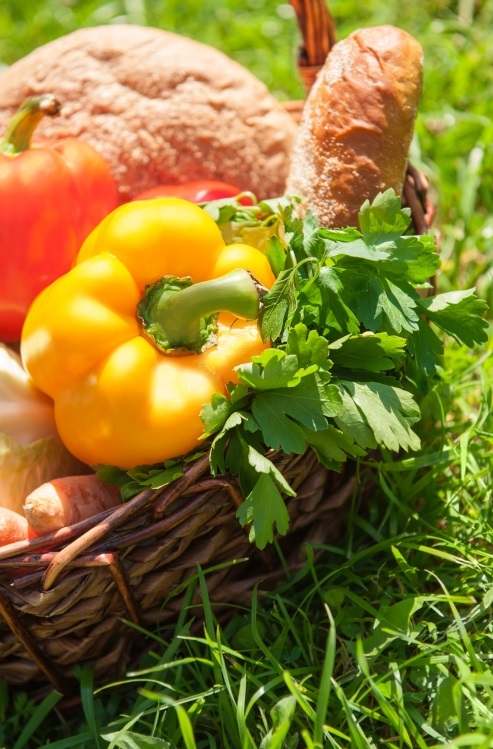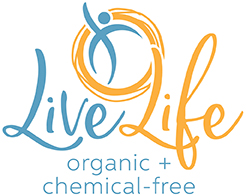
82% of households in the United States bought organic food in 2017.[1]
Are you one of them?
Chances are you are concerned about pesticides found in majority of our food supply.[2] That seems to be a concern of most organic food buyers.
What about artificial sweeteners, plastics and packaging – all of which are added to or can leach chemicals into our food supply? Are you concerned about those, too?
There are actually 5 main ways that chemicals get into our food and drink.[3]
5 Ways Chemicals Get Into Our Food
Food can have chemicals added during the growing process, manufacturing process, packaging, transportation and when in stores.[4] Here’s more info on each:
1. Growing Process
Growing refers to everything it takes to grow food. What’s put into the soil, sprayed onto the seeds, plants and food, added to the water supply that the plants used to grow and produce food. Examples of chemicals often used during the growing process include:
- Pesticides
- Fertilizers
- Insecticide
2. Manufacturing Process & Marketing
These two categories go hand-in-hand. Chemicals are added to food to make them more marketable – more tasty, more colorful, more appealing to the senses, more addictive.[5] These chemicals are added during the manufacturing process in the form of:
- Artificial sweeteners
- Thickening agents
- Taste enhancers
- Dyes or color enhancing agents
3. Packaging
All it takes is a quick glance in the cabinets and fridge to see the sheer amount of plastic packaging used in the food industry.
I’d be willing to bet that you cabinets look like mine did – a sea of plastic with food and drinks inside. Or soup cans with plastic lining. Or boxed cereals with plastic inserts. Let’s face it, plastic is a popular food packaging material. While handy, it can:
- Plastic packaging leaches into food and drinks. Pretty cut and dry.
4. Transportation
Food absorbs the chemicals and odor in the air around it. Think of when you’ve left uncovered food in the fridge over night. It tastes like ‘fridge’.
- During transportation plastic packaging exposed to heat and moisture, which increases off-gassing of chemicals at a higher rate.[6]Food may absorb more chemicals during longer, hotter, humid transportation times.
- Vehicle exhaust. In areas of high traffic and times when more vehicles are on the road, the exhaust levels in the air are higher. It’s no secret that vehicle exhaust is full of harmful chemicals being emitted into the air.
During longer transportation times, it’s more likely that your food is exposed to higher levels of vehicle exhaust. That exhaust can be absorbed into food.
5. Stores
Indoor air quality affects both the people working in the store AND the products that are being sold. Sounds kinda weird, but if you think about it, makes total sense. When chemicals off-gas into the air they aren’t picky as to where they end up, land, or what products they affect. Here are a few examples of how grocery store environments can affect food:
- Surrounding products off-gassing. Grocery stores used to be focused on selling food. Now a-days they have large cleaning supply isles, and are embedded into big box stores selling lawn fertilizer, electronics, furniture and clothing.
All that off-gassing of chemicals can get into the food supply.
- Air fresheners. Shockingly, grocery stores have also started spraying air freshener into the store itself – not just in the bathroom like they’ve done for years. I don’t know anyone that wants perfume or cologne sprayed onto their food, so I can’t imagine that people would be thrilled to have air freshener landing on their food. Yet, here we are.
- Cleaners. When was the last time you sprayed a spray bottle and had the liquid land exactly and only in the spot you wanted it to be?
Ya, I said “never”, too.
Spray cleaners have over-spray that can land onto food or unintended surfaces. Whatever products are used to clean store shelves, conveyer belts in the checkout line, floors, and food-prep surfaces have a residue that is left behind.
That residue can stick to food and become part of your lunch or dinner. Gross.
Kick-Ass Chemical-Free Solutions!
Becoming kick-ass chemical-free is all about kicking chemicals out of your home and life! Here are the top tips for getting chemicals out of your food supply.
Growing, Manufacturing & Marketing
- Buy packaged food with the USDA Organic logo. Make sure it says “organic” on it in order to buy food that’s 95-100% organic. ‘Cuz there are other USDA certifications that say “made with organic” meaning only 70% of the ingredients are organic.
- At farmer’s markets ask if their food is organic, and if it’s been certified as organic. Local farmers that sell less than $5,000 per year (gross income) are exempt from having to be certified,[7] but they may still be truly organic. They can state that they are organic, and must keep records proving such however cannot state that they are “certified organic” and may not use the USDA Organic label.[8] You’ll have to decide for yourself if you think they’re telling the truth. Some small farmers will have websites or be well-known in the community. Ask around, do a little checking. You’ll likely have a good idea if they’re hard-core organic.
- Man-made chemical additives cannot be labeled as organic. Scan the ingredient list for the word “organic” and buy food and drinks that have lots of organic ingredients. Looking for the USDA Organic label is another way to do this quickly, for products made with 95-100% organic ingredients.
Packaging
- Buy unpackaged organic food whenever possible. Bulk bins sometimes hold tea leaves, beans, rice, flour, oats, nuts, and other dry foods. Look for unpackaged fruits and veggies in the produce department.
- Packaged in glass, if a product needs packaging, is one of the best options and widely accepted as healthy. Beverages, dressings, spaghetti sauces, olive oils are just a few packaged items that come in glass packaging.
Transportation
- Buy locally grown organic food to help reduce the amount of vehicle exhaust your food is exposed to. Look for organic food that is locally grown and has shorter travel times. Bonus: that food will also be fresher than food traveling long distances.
- Locally grown food also means less time that food is exposed to plastic packaging that may be affected by heat and moisture. Buying local organic food = good.
Stores
- Shop at health conscious stores where you can walk down the cleaner isle and hardly notice the cleaners.
- Shop online for packaged food items that are less likely to be exposed to cleaners and air fresheners.
Conclusion
Studies have shown that the majority of our food supply has pesticides and man-made chemical additives, despite 82% of Americans buying organic food. Food packaging, transportation and store environments play a role in chemicals that end up in our food supply.
Be a kick-ass chemical-free consumer and avoid these chemicals by buying USDA Organic certified food and beverages that are packaged in glass containers or not packaged at all. Bulk bins, produce tables and jars with loose leaf tea are good alternatives to plastic packaged foods. Look for locally grown foods sold at health conscious stores or farmer’s markets. Making these key changes will help to kick chemicals out of your home and body!
References
[1] Organic Trade Association, “Organic, Big Results from Small Seeds”. Infographic, Accessed April 24, 2017
[2] Organic Trade Association, “Organic, Big Results from Small Seeds”. Infographic, Accessed April 24, 2017
[3] “Toxic Chemicals in our Food System,” Fact Sheet, Physicians for Social Responsibility. Accessed February 13, 2017: 1.
[4] “Toxic Chemicals in our Food System,” Fact Sheet, Physicians for Social Responsibility. Accessed February 13, 2017: 1.
[5] The C Word Movie. Think Big Tobacco Is Bad? Look at Big Food. Video. Directed by Meghan L. O’Hara. Performed by Morgan Freeman. 2016. Zorro and Me Films Production. Accessed on Robyn O’Brien “Morgan Freeman Shows Us How Big Tobacco Became Big Food.” February 1, 2017.
Morgan Freeman Shows Us How Big Tobacco Became Big Food
[6] U.S. Consumer Product Safety Commission (CPSC), Publication 725, 2013 Revision 012013. Accessed April 24, 2018.
[7] Ervin, Jessica, Ecocert, ”USDA National Organic Program Certification.” Accessed April 24, 2018.
[8] Ervin, Jessica, Ecocert, “USDA National Organic Program Certification.” Accessed April 24, 2018.
